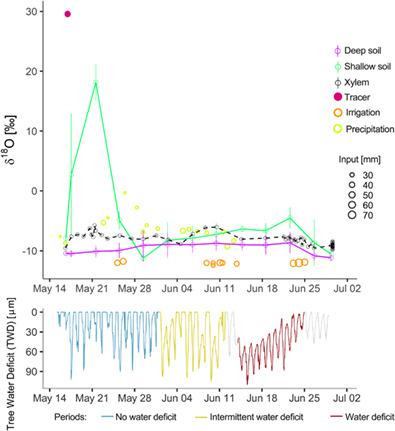当前位置:
X-MOL 学术
›
Hydrol. Process.
›
论文详情
Our official English website, www.x-mol.net, welcomes your
feedback! (Note: you will need to create a separate account there.)
Tree water deficit and dynamic source water partitioning
Hydrological Processes ( IF 2.8 ) Pub Date : 2020-12-09 , DOI: 10.1002/hyp.14004 Magali F. Nehemy 1 , Paolo Benettin 2 , Mitra Asadollahi 2 , Dyan Pratt 1 , Andrea Rinaldo 2, 3 , Jeffrey J. McDonnell 1, 4
Hydrological Processes ( IF 2.8 ) Pub Date : 2020-12-09 , DOI: 10.1002/hyp.14004 Magali F. Nehemy 1 , Paolo Benettin 2 , Mitra Asadollahi 2 , Dyan Pratt 1 , Andrea Rinaldo 2, 3 , Jeffrey J. McDonnell 1, 4
Affiliation

|
The stable isotopes of hydrogen and oxygen (δ2H and δ18O, respectively) have been widely used to investigate tree water source partitioning. These tracers have shed new light on patterns of tree water use in time and space. However, there are several limiting factors to this methodology (e.g., the difficult assessment of isotope fractionation in trees, and the labor‐intensity associated with the collection of significant sample sizes) and the use of isotopes alone has not been enough to provide a mechanistic understanding of source water partitioning. Here, we combine isotope data in xylem and soil water with measurements of tree's physiological information including tree water deficit (TWD), fine root distribution, and soil matric potential, to investigate the mechanism driving tree water source partitioning. We used a 2 m3 lysimeter with willow trees (Salix viminalis) planted within, to conduct a high spatial–temporal resolution experiment. TWD provided an integrated response of plant water status to water supply and demand. The combined isotopic and TWD measurement showed that short‐term variation (within days) in source water partitioning is determined mainly by plant hydraulic response to changes in soil matric potential. We observed changes in the relationship between soil matric potential and TWD that are matched by shifts in source water partitioning. Our results show that tree water use is a dynamic process on the time scale of days. These findings demonstrate tree's plasticity to water supply over days can be identified with high‐resolution measurements of plant water status. Our results further support that root distribution alone is not an indicator of water uptake dynamics. Overall, we show that combining physiological measurements with traditional isotope tracing can reveal mechanistic insights into plant responses to changing environmental conditions.
中文翻译:

树木缺水与动态源水分配
的氢气和氧气(δ稳定同位素2 H和δ 18O,分别)已被广泛用于调查树木水源分配。这些示踪剂揭示了树木在时间和空间上的用水模式。但是,这种方法存在一些局限性因素(例如,树木中同位素分级的困难评估以及与收集大量样本相关的劳动强度),仅使用同位素不足以提供机制了解水源分配。在这里,我们将木质部和土壤水中的同位素数据与树木的生理信息(包括树木水分亏缺(TWD),细根分布和土壤基质势)的测量结果结合起来,以研究驱动树木水源分配的机制。我们在柳树上使用了2 m 3的溶度计(柳柳),以进行高时空分辨率的实验。TWD提供了植物水状况对水供需的综合响应。同位素和TWD的联合测量表明,水源分配中的短期变化(几天之内)主要由植物对土壤基质势变化的水力响应决定。我们观察到土壤基质势与TWD之间关系的变化与源水分配的变化相匹配。我们的结果表明,在几天的时间范围内,树木的用水是一个动态过程。这些发现表明,可以通过高分辨率测量植物水分状况来确定树木在几天内对水的可塑性。我们的结果进一步支持了仅根系分布并不能指示水分吸收动态。总体,
更新日期:2021-01-19
中文翻译:

树木缺水与动态源水分配
的氢气和氧气(δ稳定同位素2 H和δ 18O,分别)已被广泛用于调查树木水源分配。这些示踪剂揭示了树木在时间和空间上的用水模式。但是,这种方法存在一些局限性因素(例如,树木中同位素分级的困难评估以及与收集大量样本相关的劳动强度),仅使用同位素不足以提供机制了解水源分配。在这里,我们将木质部和土壤水中的同位素数据与树木的生理信息(包括树木水分亏缺(TWD),细根分布和土壤基质势)的测量结果结合起来,以研究驱动树木水源分配的机制。我们在柳树上使用了2 m 3的溶度计(柳柳),以进行高时空分辨率的实验。TWD提供了植物水状况对水供需的综合响应。同位素和TWD的联合测量表明,水源分配中的短期变化(几天之内)主要由植物对土壤基质势变化的水力响应决定。我们观察到土壤基质势与TWD之间关系的变化与源水分配的变化相匹配。我们的结果表明,在几天的时间范围内,树木的用水是一个动态过程。这些发现表明,可以通过高分辨率测量植物水分状况来确定树木在几天内对水的可塑性。我们的结果进一步支持了仅根系分布并不能指示水分吸收动态。总体,











































 京公网安备 11010802027423号
京公网安备 11010802027423号